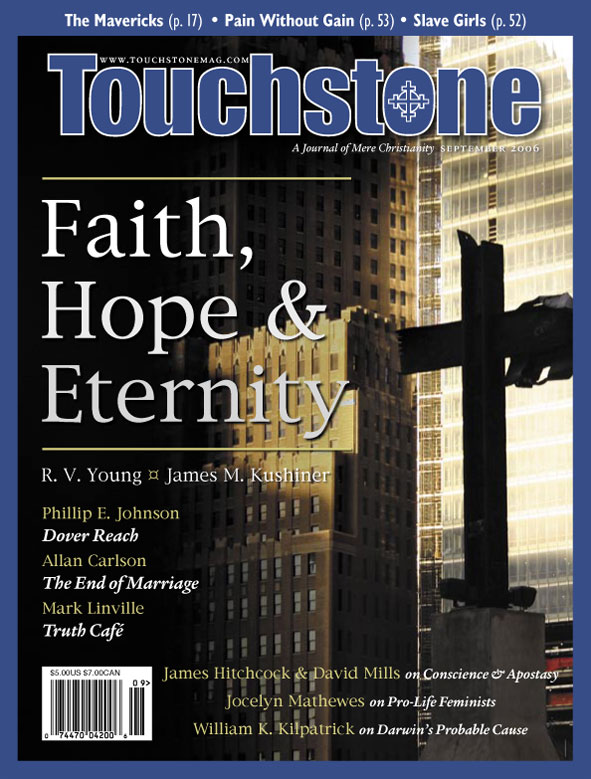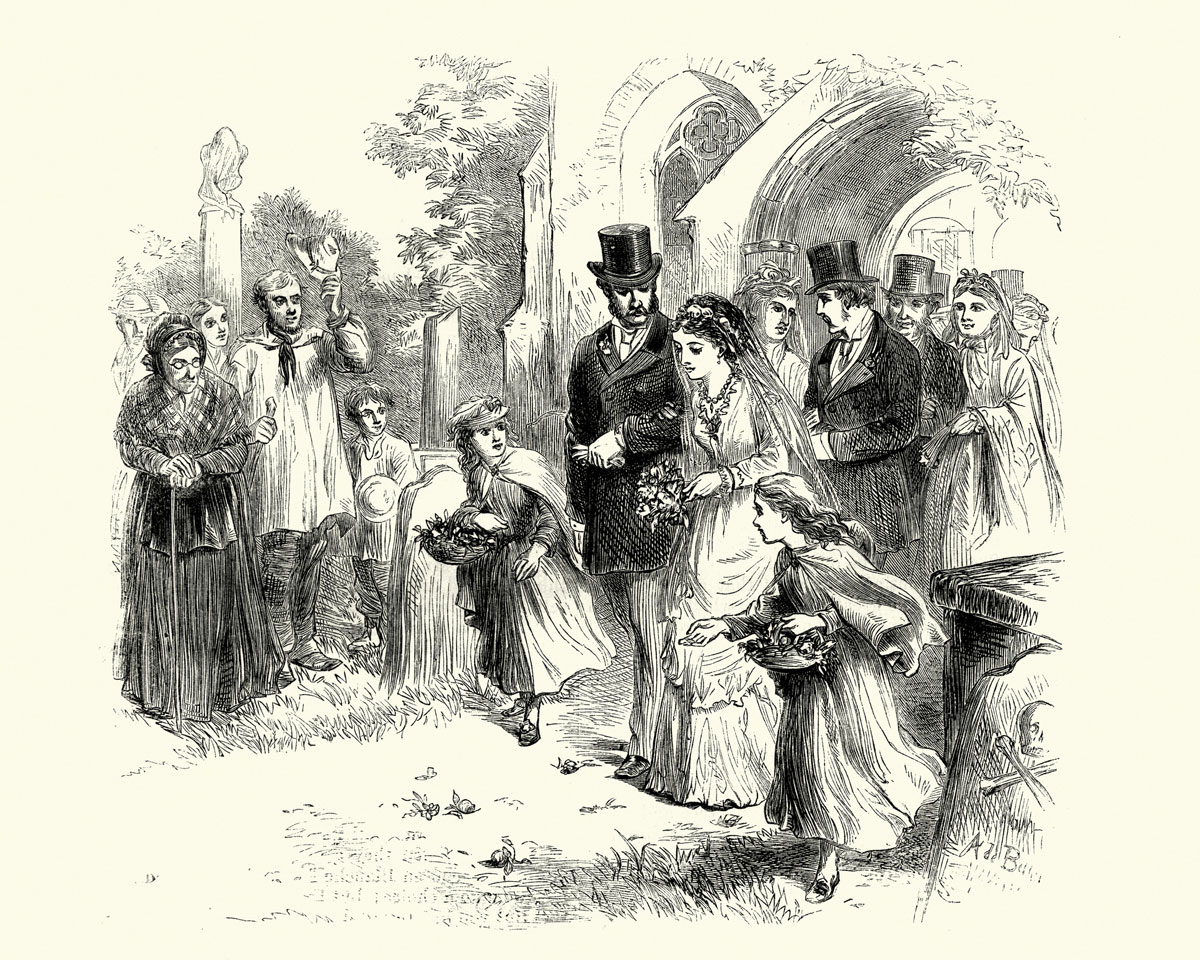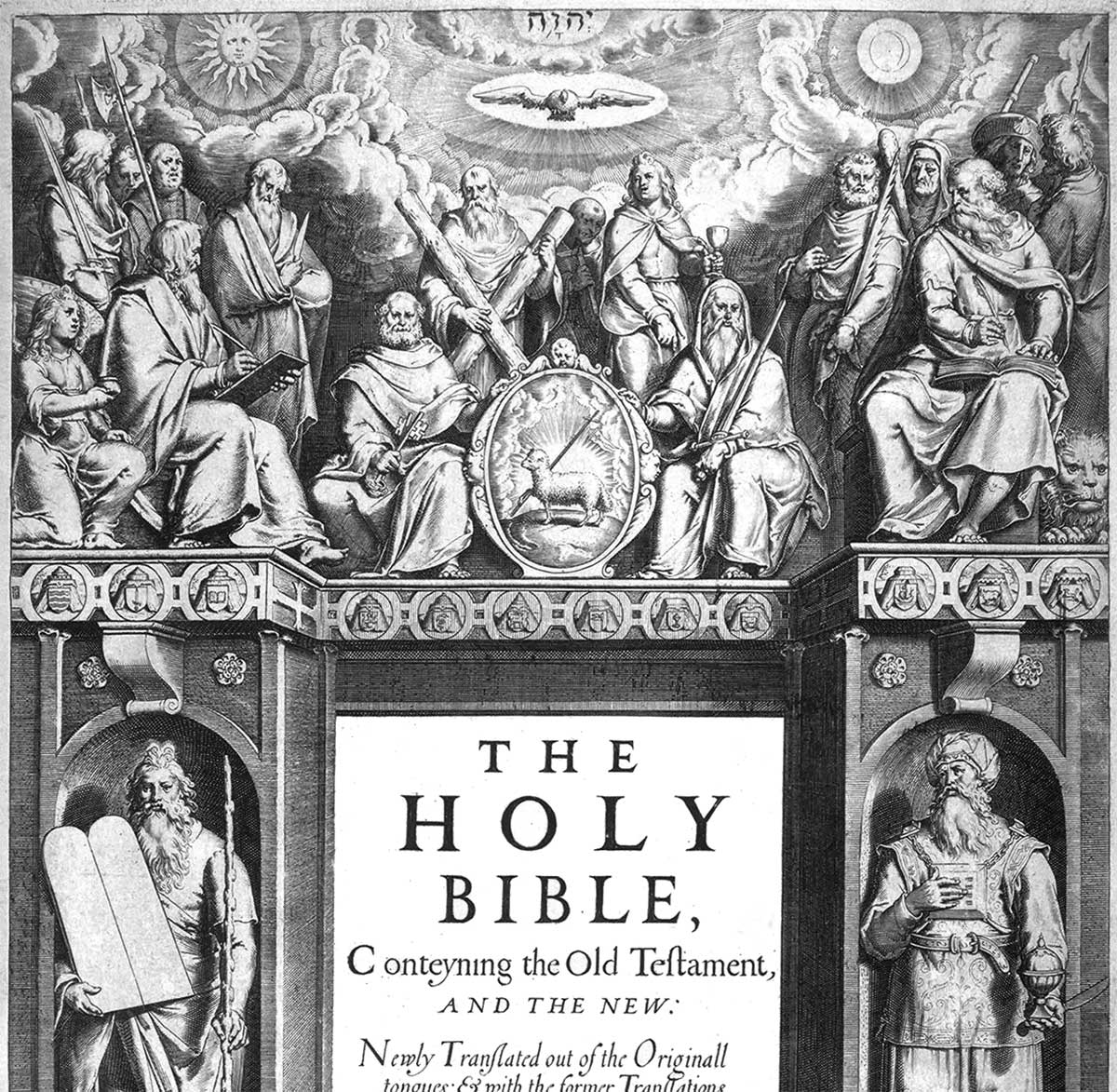Feature
The End of Marriage
Sex, Procreation & the Gnostic Triumph
by Allan Carlson
When Massachusetts officials set out to defend that state’s marriage law from a challenge by seven homosexual couples, their major line of defense was the necessary connection of marriage with procreation. Making babies, the state argued in Goodridge v. Department of Public Health, was the first purpose of marriage. By definition, same-sex partners could not create a child as a couple. This inability mattered, and barred them from marriage, because children usually do best when growing up with their two natural parents.
The trial court agreed with the state. The judge ruled that under Massachusetts law the primary purpose of marriage was in fact procreation. Accordingly, the state could reasonably distinguish between homosexual claimants to marriage and those heterosexual couples at least “theoretically . . . capable” of procreation without relying on “inherently more cumbersome” non-coital reproductive methods.
Even Evan Wolfson, an acknowledged leader of the “gay marriage” movement, in his book Why Marriage Matters agreed that:
At first glance, the “basic biology” argument seems to make some sense. After all, it doesn’t take more than a fourth-grade health class education to know that men’s and women’s bodies in some sense “complement each other” and that when a man and a woman come “together as one flesh” it often leads to procreation.
But of course, on a four-to-three vote Massachusetts’ Supreme Judicial Court dismissed the procreation argument, pointing to couples in which the woman was over childbearing age or that were otherwise infertile. The state could not “rationally” tell them that they could not marry.
Indeed, the court noted, under state law even those “who cannot stir from their death bed may marry,” provided they were of the opposite sex. Moreover, infertility was not a ground for divorce, and by inference so not a bar to marriage either. In addition, Massachusetts law protected the parental rights of homosexuals and allowed same-sex couples to adopt children, and to enable “gay parenting” while denying the children involved the benefits of “family stability and economic security” found in a marital home was irrational.
If procreation is the purpose of marriage, Wolfson argues, the marriages of Bob and Elizabeth Dole, John and Teresa Heinz Kerry, and Pat and Shelley Buchanan should all be declared invalid. So should the marriage of the Father of our Country, George Washington, to Martha.
Another same-sex activist, Dale Carpenter, writing in the Bay Area Reporter, argues that if there was any merit to the procreation argument,
We would require prospective married couples to sign an affidavit stating that they are able to procreate and intend to procreate. If in, say, 10 years they had not procreated, we could presume they are unable or unwilling to do so and could dissolve the marriage as unworthy of the unique institution.
Since no one has proposed this, or anything like it, the defenders of marriage “do not take the narrow procreationist view of marriage very seriously.” Instead, they impose another rule: “Nobody is required to procreate in order to marry, except gay couples.” Such discrimination, he implies, could not survive a test by the “equal protection clause” of the Fourteenth Amendment.
Indeed, conservative Supreme Court Justice Antonin Scalia noted in his dissent in Lawrence v. Texas that:
If moral disapprobation of homosexual conduct is of “no state interest” for purposes of proscribing [private adult sex], what justification could there possibly be for denying the benefits of marriage to homosexual couples? Surely not the encouragement of procreation, since the sterile and the elderly are allowed to marry.
When the Massachusetts Supreme Judicial Court, Evan Wolfson, and Antonin Scalia agree, it is fair to conclude that the procreation argument is in serious trouble. But before abandoning it, we should examine the bond between marriage and procreation. Where did it come from? Why is it no longer self-evident? What earlier developments weakened the procreative nature of marriage? And is it possible to salvage this appeal to procreation in the same-sex marriage debate?
The Sexual Constitution
Turning to the first question—where did the bond between marriage and procreation come from?—my answer is simple: It is no less than the foundation for what we might call the unwritten Sexual Constitution of our civilization.
Nearly two thousand years ago, what would become Western Christian civilization began to take form in a time of great sexual disorder. The moral and family disciplines of the old Roman Republic were gone, replaced by the intoxications of empire. Slave concubinage flourished in these years. Divorce by mutual consent was easy, and common. Adultery was chic, and widespread. Homo-sexuality was a frequent practice, particularly between men and boys. There was a callous disregard for infant life, with infanticide (especially of girls) a regular practice.
Caesar Augustus, worried about the plummeting Roman birthrate, even implemented the so-called “Augustan Laws” in 18 B.C., measures that punished adultery, penalized childlessness, and showered benefits on families with three or more children. These laws may have slowed, but did not reverse, the moral and social deterioration.
Between A.D. 50 and 300, and out of this same chaos, the Fathers of the Church crafted a new sexual order. Procreative marriage served as its foundation. Importantly, they built this new order in reaction to the Gnostic heresies, which threatened the young Church—which indeed threatened all human life.
The Gnostic idea rose independently of Christianity, but the so-called Christian Gnostics claimed to have a special “gnosis,” a unique wisdom or secret knowledge denied to ordinary Christians. More troubling, they also appealed to the freedom from the law as proclaimed by Christ and Paul, believing that the gospel freed Christians from obedience to any law, be it scriptural, civil, or moral. Virtually all rejected marriage as a child-related institution and scorned procreation.
This heresy posed a grave challenge to the early Christian movement. Indeed, the Epistles are replete with warnings against Gnostic teachings. In 1 Timothy 4, for example, Paul writes that “some will depart from the faith by giving heed to deceitful spirits and doctrines of demons . . . who forbid marriage.”
In Jude 4 we read that admission into the Christian community “has been secretly gained by . . . ungodly persons who pervert the grace of our God into licentiousness.” Second Peter tells of false prophets corrupting the young Church, “irrational animals, creatures of instinct . . . reveling in their dissipation, carousing with you. They have eyes full of adultery, insatiable souls.”
Similar warnings or admonitions are found in Romans (6:1; 8:2), 1 Corinthians (5:1–8; 6:12–13), Galatians (5:13), Ephesians (5:5–7), Philippians (3:18), 2 Timothy (3:6–7), and Revelation (2:14–15). Simon Magus, described in Acts, chapter 8, was probably a Gnostic.
Relative to sex, Gnosticism took two forms. One strand, claiming the freedom of the gospel, emphasized total sexual license. Clement of Alexandria described the Gnostics in the church of Alexandria who called intercourse “a mystical communion” and “have impiously called by the name of communion any common sexual intercourse. . . . These thrice-wretched men treat carnal and sexual intercourse as a sacred religious mystery, and think that it will bring them to the Kingdom of God.”
The other strand totally rejected sexuality, saw marriage as corruption and fornication, and demanded lifelong abstinence. In the heretical Gospel According to the Egyptians, Salome asks, “How long shall men die?” and Jesus answers, “As long as you women bear children.”
These Gnostics also celebrated androgyny, since a being without sexual identity could not procreate. The heretical Gospel of Thomas has Jesus saying, “Every woman who makes herself male enters the Kingdom of Heaven.” The celibate alone would enjoy the Kingdom of God.
Christian Marriage
“ The whole thrust of the antinomian [Gnostic] current,” wrote the historian John Noonan in his book Contraception, “was to devalue marriage, to deprive marital relations of any particular purpose, and to value sexual intercourse as experience [alone].” In a Roman civilization sliding into family breakdown and sexual hedonism, the young Christian Church faced as well this infiltration of life-denying, socially destructive ideas into its own ranks. For Christians, the great question became: Just what is marriage for?
The answers came from several sources. The church fathers noted, for example, the Gnostics’ fierce hatred for the Hebrew Scriptures, which saw children as a divine blessing for their parents and for the community as a whole. As told in Deuteronomy:
And because you harken to these ordinances, and keep and do them, the Lord your God will keep with you the covenant and the steadfast love which he swore to your fathers to keep; he will love you, bless you, and multiply you; he will also bless the fruit of your body. . . . You shall be blessed above all peoples; there shall not be male or female barren among you. . . . (7:12–14)
Genesis was filled with promises from God to the patriarchs that their wives should be fruitful and that the Lord “will multiply your descendants as the stars of heaven and as the sand which is upon the seashore” (22:17).
Throughout the centuries, Jewish sages have spoken like this. To give just two examples from the Babylonian Talmud: “One without children is considered as though dead,” and “he who does not engage in procreation is as if he diminished the Divine image.” Similarly Philo, a Jew trained in Greek philosophy, condemned homosexuality because, “like a bad husbandman, [the homosexual] spends his labor night and day on soil from which no growth at all can be expected.” Seeking a consistent sexual standard, he even condemned marriage to women known to be sterile.
Another source for early Christian leaders may have been the Stoic ideal. Repulsed by the sexual excesses of first-century Rome, Stoic philosophers like Epictetus summoned reason to control human desires and behavior. Moderation in all things, including sexuality, was their goal.
They also held that there was a natural law which gave purpose to human life and which revealed acts unworthy of human beings. Sexual intercourse in marriage, some of the Stoics concluded, found its clear and natural purpose in the propagation of the human race, but intercourse only for pleasure was suspect. As the first-century Stoic Seneca declared:
All love of another’s wife is shameful; so too, too much love of your own. A wise man ought to love his wife with judgment, not affection. Let him control his impulses and not be borne headlong into copulation. Nothing is fouler than to love a wife like an adulteress. . . . Let them show themselves to their wives not as lovers, but as husbands.
These Stoic teachings had a particularly strong effect on Clement of Alexandria. Indeed, according to Noonan, Clement’s influential thoughts on the purposes of Christian marriage contained in his Stromata were more or less “a paraphrase” of the Stoic Musonius Rufus.
Gospel Marriage
And of course, these early Christians drew on the positive references to marriage in the Gospels and the letters of Paul. The Gospels showed Jesus attending the wedding feast at Cana and there performing his first miracle. Jesus also condemned adultery and divorce.
In 1 Timothy 2:15, Paul wrote that “woman will be saved through bearing children.” And in Ephesians 5, he equated the marital love of husband and wife to the bond between Christ and his Church:
Wives, be subject to your husbands, as to the Lord. For the husband is the head of the wife as Christ is the head of the Church. . . . Husbands, love your wives, as Christ loved the Church and gave himself up for her. . . . “For this reason a man shall leave his father and mother and be joined to his wife, and the two shall become one.” This is a great mystery. . . .
All of these cultural and scriptural sources led the church fathers to an important conclusion: The purpose of marriage is procreation. While celebrating lifelong celibacy, they refused to abandon the need for children and the good of procreation. A host of quotations (of which the following is a very small sample) show this.
As Justin Martyr explained in the mid-second century:
“We Christians either marry only to produce children, or, if we refuse to marry, are completely continent.” God, said Irenaeus of Lyon later in the century, “made male and female for the propagation of the human race.” Two centuries later, John Chrysostom taught that “there are two reasons why marriage was instituted, that we may live chastely and that we may become parents.”
In the year 400, Augustine argued in The Good of Marriage that God desired man’s perpetuation through marriage. Offspring, he insisted, were the obvious and first “good” of marriage (the other two being fidelity and symbolic stability or sacrament). “What food is to the health of man,” he argued, “intercourse is to the health of the human race, and each is not without its carnal delight which cannot be lust if, modified and restrained by temperance, it is brought to a natural use [i.e., procreation].” In another work, he insisted that the act of procreation included “the receiving of [children] lovingly, the nourishing of them humanely, the educating of them religiously.”
A Lasting Morality
The bond of marriage to procreation would help define Western Christian civilization for another 1,500 years. Even the Protestant Reformation in the sixteenth century probably did more to strengthen than to weaken this powerful tie between procreation and marriage.
Martin Luther, for example, believed that God’s words “Be fruitful and multiply” were more than a command. They were, he wrote in 1520 in The Estate of Marriage, “a divine ordinance which it is not our prerogative to hinder or ignore.” He rejected celibacy as a special spiritual state and encouraged even priests, monks, and nuns to marry and have children.
“We were all,” he wrote in An Exhortation to the Knights of the Teutonic Order That They Lay Aside False Chastity and Assume the True Chastity of Wedlock, “created to do as our parents have done, to beget and rear children. This is a duty which God has lain upon us, commanded, and implanted in us, as is proved by our bodily members, our daily emotions, and the example of all mankind.”
Protestantism did inject more passion and intimacy into the marital bond than was considered seemly by the Fathers, but these emotions remained tightly bound to procreation. Consider, for example, this poem written by the Puritan wife, Anne Bradstreet, to her husband Simon, one of the founders of the Massachusetts Bay Colony in 1630. It is entitled “A Letter to Her Husband, Absent upon Publick Employment”:
I, like the earth this season, mourn in black,
My Sun is gone so far in’s Zodiack,
Whom whilst I ’joy’d, nor storms, nor frosts I felt,
His warmth such frigid colds did cause to melt.
My chilled limbs now nummed lye forlorn;
Return, return sweet Sol from Capricorn;
In this dead time, alas, what can I more
Than view those fruits which through thy heat I bore.
The “fruits” referred to here are, of course, their children, the offspring of Christian marital ardor and love.
Closer to our time, attitudes toward contraception revealed the continuing strength of the bond between marriage and procreation. Even in the late nineteenth century, the free-love feminists then emerging in New England refused to endorse birth control. According to the feminist historian Linda Gordon’s Woman’s Body, Woman’s Right:
The basis for this reluctance lies in their awareness that a consequence of effective contraception would be the separation of sexuality from reproduction. A state of things that permitted sexual intercourse to take place normally, even frequently, without the risk of pregnancy inevitably seemed to nineteenth-century middle class women to be an attack on the family.
As late as 1917, the unwritten Sexual Constitution of our civilization—crafted nearly two thousand years before—remained intact. In that year, no less a body than the Massachusetts Supreme Judicial Court ruled in favor of a law prohibiting the distribution of contraceptives. As the Massachusetts Court reasoned in Commonwealth v. Allison, the law’s “plain purpose is to protect purity, to preserve chastity, to encourage continence and self-restraint, to defend the sanctity of the home, and thus to engender in the State and nation a virile and virtuous race of men and women.”
Contraceptive Penumbras
However, this appeal to “a virile and virtuous race of men and women,” and implicitly to the tight bond between marriage and procreation, would unravel. This story could be told many ways. I want to focus on two episodes, one in America, one in another Western land: the legalization of contraception here and the disappearance of the concept of illegitimacy in Sweden.
Regarding the first, Wolfson writes in Why Marriage Matters that “to hear the opponents of gay equality today, one would not know that for decades the law of the land . . . has been to recognize that marriage is not just about procreation—indeed it is not necessarily about procreation at all.” He is, unfortunately, correct.
The Supreme Court’s 1965 ruling in Griswold v. Connecticut stands in ever sharper relief as a profound break in American, and Western, history. Authored by Justice William O. Douglas, the Court’s opinion overturned a Connecticut law prohibiting the use of contraceptives. In doing so, it also claimed to discover, for the first time, “penumbras” around and “emanations” from the Bill of Rights, new legal spirits that created “zones of privacy” hitherto unknown. (Such strange language would have been familiar to a first-century Gnostic.)
The Court appealed to “the sacred precincts of marital bedrooms” and to “the notions of privacy surrounding the marriage relationship” to justify its decision. Indeed, the opinion concluded:
We deal with a right of privacy older than the Bill of Rights—older than our political parties, older than our school system. Marriage is a coming together for better or for worse, hopefully enduring and intimate to the degree of being sacred. . . . [I]t is an association for as noble a purpose as any involved in our prior decisions.
In truth, Griswold represented a direct assault on our civilization’s unwritten Sexual Constitution. As Wolfson notes, “The Court recognized the right not to procreate in marriage.” Indeed, only six years later, in Eisenstadt v. Baird, the Supreme Court appealed to the same “penumbras” and “emanations” from the Bill of Rights, to the same “right of privacy,” in order to declare marriage largely empty of meaning:
It is true that in Griswold the right of privacy in question inhered in the marital relationship. Yet the marital couple is not an independent entity with a mind and heart of its own, but an association of two individuals each with a separate intellectual and emotional makeup. If the right of privacy means anything, it is the right of the individual, married or single, to be free from unwarranted governmental intrusion into matters so fundamentally affecting a person as the decision whether to bear or beget a child.
With this decision, the “penumbras” and “emanations” of the Constitution denied the substance of both marriage and the natural law. A year later, in 1973, the same secret knowledge led the Supreme Court to overturn the abortion laws of all fifty states, creating a new “right to abortion” (a right that would surely have pleased the baby-hating Gnostics).
In 1992, in the notorious decision in Planned Parenthood of Southeastern Pennsylvania v. Casey, the Court appealed to “the right to define one’s own concept of existence, of meaning, of the universe, and of the mystery of human life” in its reaffirmation of abortion rights (language very close to a definition of the Gnostic idea). And in 2003, the Court in Lawrence v. Texas summoned the same “penumbras” and “emanations” to find a right to uninhibited sexual expression, a right to sodomy (yet again something the Gnostics would have understood and approved).
On Illegitimacy
This leads us to the second episode in the disappearance of the bond between marriage and procreation: the decline and fall of the concept of “illegitimacy” as part of our civilization’s unwritten Sexual Constitution.
The cultural and legal term “illegitimate birth” sought to use fear and shame to help confine sexual relations and childbearing to marriage. The term bothers even cultural conservatives today, because it punishes innocent children for the mistakes of their parents, and others because it “privileges” marriage.
There were earlier attempts to banish the term. In 1793, the French Revolution’s Law of 12 Brumaire swept away all laws that distinguished between legitimate and illegitimate children. “There are no bastards in France!” the revolutionaries triumphantly declared. And yet the change was opposed in the countryside, and was never really enforced by the courts. It was repealed in 1803.
In 1918, the Bolshevik revolutionaries in Russia also abolished “illegitimacy,” with the new Soviet Family Law Code stating that “birth itself shall be the basis of the family. No differentiation whatsoever shall be made between relationship by birth in or out of wedlock.”
This, with divorce on request by either spouse and the equation of cohabitation with marriage, was part of the larger Communist project to eliminate marriage and the natural family altogether. As Bukharin told the 1924 Congress of the Communist Party of the Soviet Union: “The family is a formidable stronghold of all the turpitudes of the old regime.” It had to go.
And yet these reforms did not work. Child abandonment grew common. Vagrant children filled the land. In the end, even Stalin acknowledged failure. A new Family Code, introduced in 1944, specified that only a registered marriage created rights and duties between husband and wife, parent and child. The idea of “illegitimacy” returned.
Swedish Success
However, a far more successful project to abolish “illegitimacy” occurred in Sweden during the last three decades of the twentieth century. It succeeded only by simultaneously deconstructing marriage and substituting a massive welfare state for the home.
Back in 1915, Sweden had already removed the terms “legitimate” and “illegitimate” from its legal codes, inserting “born in” and “born out of wedlock” instead. The change had no immediate impact. Into the early 1960s, Swedish family life remained relatively strong and vital.
Only during Sweden’s so-called Red Years, 1967 to 1976, did real changes occur. Under heavy feminist influence, the Democratic Socialist government set out to abolish the roles of husband and wife, to make divorce easy, to eliminate marriage as an economic unit, and to raise the status of cohabitation to equality with marriage.
Notably, in 1976—at the very end of this radical reform—the government deleted the terms “born in” and “born out of wedlock” from all its statutes. This fully severed the legal bond between marriage and procreation.
To make this work, the Social Democrats had to expand the welfare state, with government now supplying most of the support and care of children once given by families, from universal health insurance, to massive day care subsidies, to state child allowances, to school meals. With the home so dismantled, and with procreation already unrelated to marriage, it was an easy and logical step to extend marriage-like “registered partnerships” to same-sex couples in 1995.
The leveling “right of privacy” in America; the triumph of the state over the home in Sweden: both contributed to the successful repeal of the Sexual Constitution of Western civilization, which had rested on the fundamental bond of marriage to procreation.
The Gnostic Society
So where are we left? Can we still defend the purpose of marriage as procreation? No. The “right of privacy,” conceived by the Supreme Court nearly four decades ago, is the enemy of both marriage and procreation separately, and is especially hostile when they are united. We lost the key battles in defense of this union decades ago, long before anyone even imagined same-sex marriage.
And we lost these battles over questions that—if we are honest—relatively few of us are really prepared to reopen. How many are ready to argue for the recriminalization of contraception? How many want to argue for a strict legal and cultural imposition of the word illegitimate on certain little children?
The opponent we now face is something at once new and different and as old as time. The Gnostic idea is back, in new guise. It shapes everything from modern feminist theology (consider Elaine Pagels’s bestselling Beyond Belief: The Secret Gospel of Thomas), to popular literature ( The Da Vinci Code is an openly Gnostic text), to the reasoning of our highest court.
No appeal to nature, to history, to civilization, or to human experience of any kind can prevail against the “special knowledge” of the modern antinomians who have dominated our Supreme Court and still hold a small majority. Indeed, nothing that is natural, traditional, cultural, religious, social, or moral is safe from the Gnostic idea. •
Sources: the Jewish sages, the Babylonian Talmud Nedarim (64b and 63b); Philo, The Special Laws (3.36); Seneca, Fragments (no. 84); Augustine, The Good of Marriage and On Genesis According to the Letter (9.7); Luther, Luther’s Works, volume 45 of the collected works published by Muhlenburg Press; Bradstreet’s poem can be found in Harrison T. Meserole’s Seventeenth-Century American Poetry; Soviet marriage policy is discussed in Jenny Teichman’s Illegitimacy: An Examination of Bastardy.
Political Connections
There may be political acts that would reconnect procreation and marriage. For example, we could turn one of the marital innovators’ key arguments back on them. Perhaps we should restrict some of the legal and welfare benefits of civil marriage solely to those married during their time of natural, procreative potential: for women, below the age of 45 or so (for men, in the Age of Viagra, the line would admittedly be harder to draw).
The idea is not without political precedence. In 1969, the powerful chairman of the House Ways and Means Committee, Wilbur Mills, wanted to respond to complaints by unmarried adults that existing tax law unfairly favored the married. He wanted to preserve this “marriage bonus” for the young and fertile, while still helping those he labeled (in now archaic language) “spinsters.”
He proposed maintaining the benefits only for married persons under the age of 35. The proposal went nowhere. The Nixon administration and Congress chose instead to reduce the benefits for all married persons and created the “marriage penalty” with which we still grapple today.
Another, and perhaps more realistic way to rebind marriage and procreation would be, counter- intuitively, to take some of the benefits currently attached to marriage and reroute them instead through children. Allow me one practical example here. Most households with two or more children will likely continue to be married-couple, natural-parent homes. These are still, and always will be, the places most open to what we once called “a full quiver.”
We could encourage them by tying retirement benefits to family size: that is, the more children that a couple brought into the world, the higher their later monthly Social Security benefit. Or we could create a new tax credit against payroll taxes: rebating, say, 20 percent of the current 15.3 percent tax facing parents for each child born. These ideas would indirectly favor child-rich homes, and most of these homes, in the American context, would contain a married couple.
These approaches are, admittedly, tangential. However, bolder steps are all but impossible until we see profound changes in the membership and thinking of our highest court and until we as a people actually want to restore the unwritten Sexual Constitution of our civilization, including the hard parts. It may be that the first requirement—changing the Court—will prove easier to achieve than the second.
— Allan Carlson
Allan C. Carlson is the John Howard Distinguished Senior Fellow at the International Organization for the Family. His most recent book is Family Cycles: Strength, Decline & Renewal in American Domestic Life, 1630-2000 (Transaction, 2016). He and his wife have four grown children and nine grandchildren. A "cradle Lutheran," he worships in a congregation of the Lutheran Church-Missouri Synod. He is a senior editor for Touchstone.
bulk subscriptions
Order Touchstone subscriptions in bulk and save $10 per sub! Each subscription includes 6 issues of Touchstone plus full online access to touchstonemag.com—including archives, videos, and pdf downloads of recent issues for only $29.95 each! Great for churches or study groups.
Transactions will be processed on a secure server.
more on sex from the online archives
more from the online archives
calling all readers
Please Donate
"There are magazines worth reading but few worth saving . . . Touchstone is just such a magazine."
—Alice von Hildebrand
"Here we do not concede one square millimeter of territory to falsehood, folly, contemporary sentimentality, or fashion. We speak the truth, and let God be our judge. . . . Touchstone is the one committedly Christian conservative journal."
—Anthony Esolen, Touchstone senior editor














